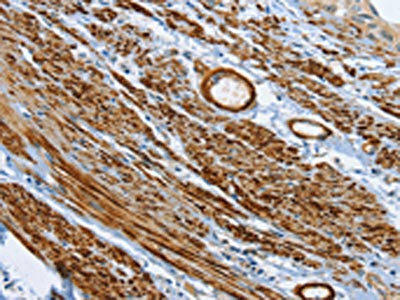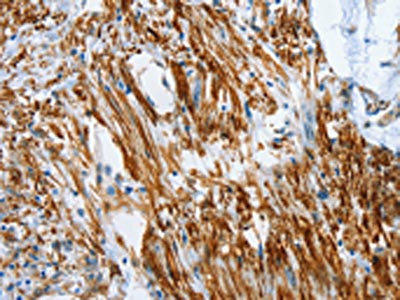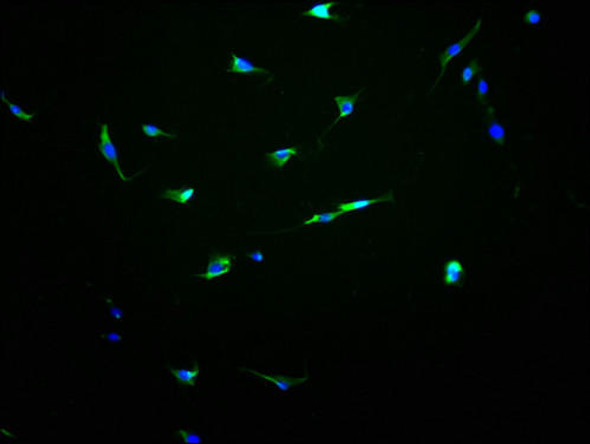Description
| Antibody Name: | SHROOM2 Antibody (PACO19129) |
| Antibody SKU: | PACO19129 |
| Size: | 50ul |
| Host Species: | Rabbit |
| Tested Applications: | ELISA, IHC |
| Recommended Dilutions: | ELISA:1:2000-1:5000, IHC:1:50-1:200 |
| Species Reactivity: | Human |
| Immunogen: | Synthetic peptide of human SHROOM2 |
| Form: | Liquid |
| Storage Buffer: | -20°C, pH7.4 PBS, 0.05% NaN3, 40% Glycerol |
| Purification Method: | Antigen affinity purification |
| Clonality: | Polyclonal |
| Isotype: | IgG |
| Conjugate: | Non-conjugated |
 | The image on the left is immunohistochemistry of paraffin-embedded Human cervical cancer tissue using PACO19129(SHROOM2 Antibody) at dilution 1/50, on the right is treated with synthetic peptide. (Original magnification: x200). |
 | The image on the left is immunohistochemistry of paraffin-embedded Human colon cancer tissue using PACO19129(SHROOM2 Antibody) at dilution 1/50, on the right is treated with synthetic peptide. (Original magnification: x200). |
| Background: | The protein encoded by this gene shares significant similarities with the apical protein from Xenopus laevis which is implicated in amiloride-sensitive sodium channel activity. This gene is a strong candidate gene for ocular albinism type 1 syndrome. |
| Synonyms: | shroom family member 2 |
| UniProt Protein Function: | APXL: May be involved in endothelial cell morphology changes during cell spreading. In the retinal pigment epithelium, may regulate the biogenesis of melanosomes and promote their association with the apical cell surface by inducing gamma-tubulin redistribution. Belongs to the shroom family.Protein type: Channel, sodiumChromosomal Location of Human Ortholog: Xp22.3Cellular Component: apical plasma membrane; cell-cell adherens junction; cortical actin cytoskeleton; cytoskeleton; plasma membrane; tight junctionMolecular Function: actin binding; actin filament binding; amiloride-sensitive sodium channel activity; beta-catenin binding; protein bindingBiological Process: actin filament bundle formation; apical protein localization; brain development; camera-type eye development; camera-type eye morphogenesis; cell migration; cell morphogenesis; cellular pigment accumulation; ear development; establishment of melanosome localization; eye pigment granule organization and biogenesis; lens morphogenesis in camera-type eye; melanosome organization and biogenesis |
| UniProt Protein Details: | |
| NCBI Summary: | This gene represents the human homolog of Xenopus laevis apical protein (APX) gene, which is implicated in amiloride-sensitive sodium channel activity. It is expressed in endothelial cells and facilitates the formation of a contractile network within endothelial cells. Depletion of this gene results in an increase in endothelial sprouting, migration, and angiogenesis. This gene is highly expressed in the retina, and is a strong candidate for ocular albinism type 1 syndrome. Alternatively spliced transcript variants have been found for this gene. [provided by RefSeq, Mar 2016] |
| UniProt Code: | Q13796 |
| NCBI GenInfo Identifier: | 2498147 |
| NCBI Gene ID: | 357 |
| NCBI Accession: | Q13796.1 |
| UniProt Secondary Accession: | Q13796,B9EIQ7 |
| UniProt Related Accession: | Q13796 |
| Molecular Weight: | 176,410 Da |
| NCBI Full Name: | Protein Shroom2 |
| NCBI Synonym Full Names: | shroom family member 2 |
| NCBI Official Symbol: | SHROOM2 |
| NCBI Official Synonym Symbols: | APXL; HSAPXL |
| NCBI Protein Information: | protein Shroom2 |
| UniProt Protein Name: | Protein Shroom2 |
| UniProt Synonym Protein Names: | Apical-like protein; Protein APXL |
| Protein Family: | Protein |
| UniProt Gene Name: | SHROOM2 |
| UniProt Entry Name: | SHRM2_HUMAN |






